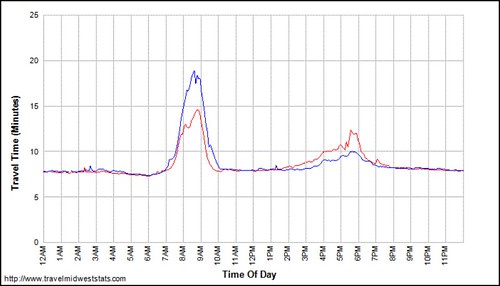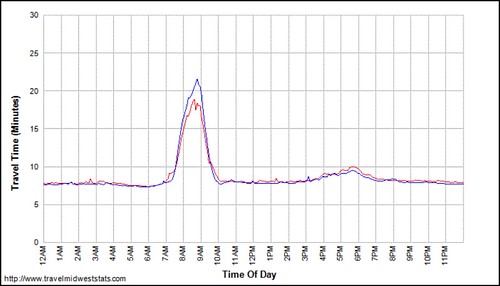When I attended the ribbon cutting for the reconfiguration of Fullerton Avenue at Lake Shore Drive last December, there was a lot of talk from city officials about how the rehab would improve safety for pedestrians and bicyclists. In reality this redesign, planned before forward-thinking Chicago Department of Transportation chief Gabe Klein took office, seems to have been done mostly for the convenience of drivers, at the expense of pedestrians and cyclists. Ironically, the new configuration seems to be delaying motorized traffic on the drive, but it's not just car commuters paying the price: the CTA’s vital express buses are also getting bogged down in congestion.
Before the rehab, people heading east to the lakefront on foot or by bike could take the sidewalk on the south side of Fullerton, which functioned as a de-facto multi-use path. Eastbound drivers turning right onto southbound LSD had to yield to non-motorized traffic, but Illinois Department of Transportation stats show there were relatively few crashes here compared to other lakefront intersections.
In effect, the Fullerton redesign “solved” this non-problem by eliminating the pedestrian and bike traffic. CDOT removed the south sidewalk and replaced it with an additional travel lane and double on-ramp, which makes it easier for motorists to enter the drive. While it used to be reasonably safe to pedal to the lakefront on the roadway, the double right-turn lane creates a hazardous situation for on-street cyclists.
People on foot and bicycles are now left with two inconvenient options to access the lake. They can make an at-grade crossing to the sidewalk on the north side of Fullerton, which requires crossing two different streets, Fullerton and Cannon Drive. Or they can take an extremely indirect car-free route that involves going down ramps, crossing under Fullerton and then coming back up to the north sidewalk via stairs or more ramps. Since many cyclists will opt to continue east on Fullerton, despite the double right-turn danger, instead of taking this circuitous route, the rehab is likely to cause more crashes than it prevents.
The apparent delay for buses on LSD adds insult to injury. Daniel Bliss, a social sciences professor at the Illinois Institute of Technology, sent us graphs he created based on data from the GCM/Travel Midwest website, which shows local travel time statistics for the region going back as far as 2004.
When traffic is flowing freely on North Lake Shore Drive, the GCM/Travel Midwest data shows it only takes seven or eight minutes to drive the 7.5 miles from Bryn Mawr Avenue to Randolph Street, Bliss says. In January 2011, before construction started on Fullerton, this trip took an additional seven to eight minutes during the a.m. rush hour. In January 2012, during the rehab project, the morning delay actually dropped to only four or five minutes. Bliss argues that this was because the roadwork slowed the rate at which cars on Fullerton could enter LSD, which reduced delays for other southbound traffic on the drive.
“Since [Fullerton] re-opened?” Bliss writes, “Disaster.” When he checked the travel times for January 2013, after the double on-ramp debuted, he found that the additional a.m. traffic delay actually spiked to 12-15 minutes over the seven-to-eight-minute drive time for free-flowing traffic. He blames the added travel time on drivers from the affluent Lincoln Park neighborhood entering LSD from Fullerton at a faster rate than before.
“The double turn lanes are a boon for a privileged few motorists in a single neighborhood, while diminishing the quality of life for everyone else,” Bliss says. “This has a particularly negative impact on the express buses that depend on Lake Shore Drive. That’s why I think CDOT really ought to take a look at this data. If they ever want to put bus rapid transit on the drive, it’s going to be very tough to get it to work with current traffic levels during the morning peak.”







